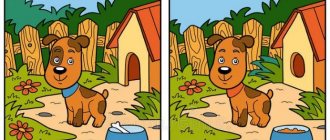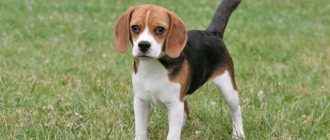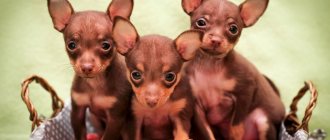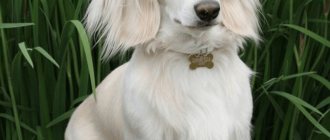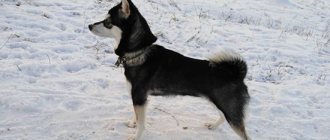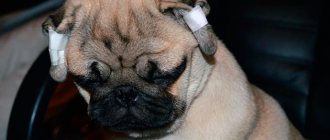Rottweiler (Rottweiler) - strong, powerful and reliable. Well, just a real man who you can rely on and be calm about your safety.
Rottweilers can be excellent watchmen, bodyguards, can transport cargo and serve in the relevant authorities - the army, the police.
Despite their (recently) bad reputation, Rottweilers are very smart and capable of the sweetest displays of the most tender feelings to both people and other animals.
Rottweilers are characterized by medium body sizes.
These dogs are not stocky and represent strength and power along with agility and endurance.
With a height of 61-68 cm, males of this breed can weigh up to 50 kg. Bitches are characterized by a height of 56-63 cm and, accordingly, less weight - up to 42 kg.
There are 4 size standards for this breed, which does not mean that there are several varieties of Rottweiler.
Photo 1. Rottweiler resting
The variety of sizes is only one of the features of this fighting breed, due to hundreds of years of formation of the qualities of Rottweilers - both physical and psychological.
For any size of the pet (or future pet), the correct ratio of body sizes will be considered the following: a fairly wide head is elongated, at the level of the scruff of the neck should not exceed 37% of the total body length in males and 36% in females.
Being a pronounced brachycephalic, the dog of this breed is distinguished by a short muzzle in relation to the head - no more than 40%. The remaining 60% of the length of the head is taken up by the skull.
A powerful and wide neck helps support the Rottweiler’s heavy head.
The eyes are dark almond-shaped. The ears are characterized by a “hanging” position; they have a triangular shape and, in relation to the overall size of the head, the ears are small and fit tightly to the head.
A scissor bite hides the brightly pigmented gums and teeth growing along the entire length of the jaw. Large nose, black, with wide nostrils.
The chest is quite wide, strong and muscular. The same can be said about the dog's bones.
Black with brownish tan, the Rottweiler's coat is of medium length with a thick undercoat.
History of the formation of the Rottweiler breed
The great-grandfather of all modern fighting breeds is the Tibetan mastiff.
Some modern researchers are ready to refute (or try to refute) this established theory. After all, there is no documentary evidence about the ancestors of the Rottweiler.
Humanity has sufficient data indicating that the threads of the pedigree of this breed stretch back to the ancient banks of the Nile, where on the walls of the tomb of Pharaoh Tutankhamun one can see drawings of impressive scale, glorifying the battles and warriors who became famous there.
These drawings also contain images of strong, large and brave dogs that fought to the death, not yielding to their masters.
Near the palaces and temples of the ancient Egyptians you can also find images and sculptures of these strong dogs.
Their history can go back to the very dawn of civilization, to 4000 BC.
Their character, spirit and courage, as well as physical qualities, were tempered in gladiatorial battles, participation in hunting and military campaigns.
Photo 2. Rottweilers are real fighting dogs
In gladiatorial fights for animals, these dogs competed against tigers and lions and even against elephants (looking at the modern Rottweiler, I wouldn’t be surprised if 3-4 of these dogs defeated an elephant).
Disputes and disputes, but at the moment it has only been proven that Molossian dogs (that’s what they were called), which had excellent guard qualities, originally appeared in Europe and were brought there by the Phoenicians.
When dogs began to crossbreed with local representatives of other breeds, this became the beginning of new species, among which the Swiss described a black dog family, from which the local bicycle herders originated.
Once they reached Germany, these dogs were crossed with English (and possibly other) hunting dogs.
Already modified descendants of European guard dogs once found themselves in the small town of Rot Weil.
Now it’s easy to guess that the name of this settlement later became the official name of this dog breed.
However, Rottweilers were not immediately called that. They were originally called "Rot Weiler butcher dogs" (Netzgerhund), which was due to the high level of trade in Rot Veil.
Meat was traded there most of all.
The city of Rottenburg should not be overlooked, the breeders from which made a significant contribution to the development of the breed.
In the end, the very first description of Rottweilers appeared, dated 1901, and the first clubs for fans of this breed began to appear in 1907.
The founder of the breed is considered to be a dog named Lord Von Der Tekka.
He was awarded this honor for his unusually wide head at that time.
Rottweilers were brought to the vast expanses of Russia (Siberia) in 1914. Why go straight to Siberia?
Because dogs of this breed can tolerate cold weather well.
Finding themselves in remote Siberian settlements, Rottweilers became guards for livestock, successfully fighting off hungry taiga predators.
Important events in the life of the breed
The origin story of the Rottweiler explains its modern qualities:
- Endurance;
- Fearlessness;
- Calm;
- High pain threshold;
- Fast reaction.
Thanks to these characteristics, the breed avoided extinction. In the 19th century, with the development of railway transport and the ban on driving livestock over long distances, the main function of the descendants of Roman cattle dogs turned out to be unclaimed. But thanks to the case, the Germans paid attention to other qualities of the animal. According to numerous surviving descriptions, a private Hamburg police officer alone with his service dog calmed a crowd of angry sailors. With this event, a new round in the history of the origin of the Rottweiler breed began.
The Fausner family made a great contribution to the development of the breed. Generations of this dynasty bred and improved Rottweilers. And in 1921, with their active participation, the United German Rottweiler Club (ADRK) was established, which approved the breed standards. But official work on breeding Rottweilers began almost 40 years before this event. Then in 1882, dogs were first presented at an exhibition in Heilborn. Modern purebred Rottweilers all over the world are descendants of the spirit cables: Leo von Cannstatt and Arko von Torferk, father and son.
Rottweiler character
When properly trained, the Rottweiler has amazing qualities.
These dogs are smart and easy-going, but at the same time they are strong and self-confident. Their external and internal calmness is by no means an optical illusion. They will never do anything that they should not or do not want to do.
They feel great both in an apartment, where you won’t notice much activity behind them, and in nature, where these dogs love to frolic.
As with any other guard or service dog, Rottweilers need to be walked more often.
Photo 3. The Rottweiler has a difficult character
Being a breed of athletic build with strong paws and bones, Rottweilers are great for morning runs and other sports activities. Especially if their leader (and it is necessary to be a leader for such a pet) encourages and shares this.
If a dog of this breed, while still a puppy, makes friends with another animal, then this will be the strongest friendship in the world.
An adult Rottweiler that has not been trained to interact with other pets may become aggressive towards the latter.
Despite the best education and training, Rottweilers do not like strangers. If there is no danger to the owner or the dog himself, then he will simply become suspicious and focused.
And one moment. Rottweilers prefer a measured and calm life. Therefore, if there is constant shouting, swearing, regular guests and “partying” in the house, then a dog of this breed can clearly show anxiety and even become aggressive.
Looks like children, doesn't it?
And despite all the arguments that Rottweilers should be feared (we’ll discuss a little later), these dogs have earned the trust of many generations of people.
It is not for nothing that a monument to this dog was erected in the city of Rot Weil. It is not for nothing that the dog Sultan was awarded a monument at the Morfino estate.
There are many other examples of owners who are grateful to their dogs and who have fully experienced how loyal a friend a Rottweiler can become.
Maintenance, care and nutrition
Content
The Rottweiler is suitable for living in a city apartment or country house, but it requires personal space. The bedding should be hard and spacious so that the dog does not develop bedsores. The dog's place should be located in a part of the house from where the pet can see family members. The Rottweiler will refuse to be in an isolated corner. He needs to spend time with people.
The breed is not suitable for keeping outside. The dog will need a warm kennel, but if the outside temperature is below -10°C, it needs to be taken indoors. Despite their thick undercoat, these dogs do not tolerate cold well, catch colds easily, and can get colds in their kidneys.
Attention: you cannot keep your Rottweiler on a chain! This threatens the development of mental problems for the dog.
This breed needs serious physical activity to develop muscle mass and release accumulated energy. You should walk for at least an hour, twice a day. Sedate walks in the park are not suitable for a Rottweiler. He needs jogging and active games. It is advisable to visit dog parks, where, in addition to working on simulators, the dog can communicate with other dogs and learn to exist in society.
Care
The Rottweiler is not very difficult to care for. The wool does not need cutting or trimming. A couple of times a week, the dog is brushed with a brush or rubberized mitten. During the molting period (autumn and spring), combing should be done as a daily procedure. Bath the dog a maximum of four times a year, using a special shampoo. The use of human detergents can cause skin problems and dandruff.
Other hygiene procedures include:
- regularly inspect your ears, remove accumulated wax with a cotton pad soaked in a weak solution of hydrogen peroxide or a special animal solution. If pus is found in the sinks, consult a doctor immediately;
- periodically wipe the eyes with chamomile infusion or weak tea;
- Teeth should be brushed every week with a finger brush or special bones (they are sold in pet stores). Neglect of this procedure leads to periodontal disease and stone formation;
- claws are trimmed as needed. It is advisable to entrust this manipulation to a specialist, since according to the breed standard they are black, it is difficult to find the place to cut, and the capillaries can be damaged.
Nutrition
It is better to feed your Rottweiler up to a year with ready-made super premium food for fast-growing breeds. It maintains a balance of substances and contains all the necessary vitamins and microelements that ensure the full development of the dog’s body. In addition, such food is easy to prepare and has a long shelf life.
Suitable brands include:
- Belcando;
- Brit;
- Bosch;
- Eukanuba.
It should be borne in mind that small Rottweilers are very gluttonous and continue to beg for more even when they are full. They cannot be indulged; the breed has a tendency to become obese. It is necessary to strictly follow the dosage of food indicated on the packaging.
After a year, the Rottweiler can be switched to natural feeding. Your dog's diet should include:
- meat (except pork);
- buckwheat;
- vegetables;
- cottage cheese;
- offal;
- rice;
- eggs;
- millet;
- fruits;
- dairy products;
- barley grits;
- sea fish (once a week).
When feeding your pet at home, you should be given vitamin and mineral complexes prescribed by a veterinarian. Once a day you should add a spoonful of vegetable oil to your food - this will improve the animal’s digestion. The Rottweiler requires bones and cartilage to develop its jaws.
It is forbidden to give the dog:
- legumes;
- bread;
- milk;
- sweets;
- sausage
- potato;
- dishes from the host's table.
Two-month-old puppies are fed six times a day, gradually reducing the number of meals to three.
Should you be afraid of Rottweilers?
According to some statistics, in the United States, more than 16% of dog bite deaths occur in the breed we are talking about.
Photo 4. A well-mannered Rottweiler is absolutely safe for others
In this regard, many insurance companies often refuse Rottweiler owners to obtain an insurance policy.
This is only due to the complete irresponsibility of people who one day decided to get themselves a pet from this breed.
Any qualified dog handler will tell you that a Rottweiler whose owner took a responsible approach to raising it will never end up in a criminal record.
How to test a Rottweiler for aggressiveness
There is a special technique for identifying dogs of this breed that are aggressive and uncontrollable.
The test is quite simple, but it should only be performed with trained people and dog handlers.
The procedure consists of two stages.
At the first stage, the dog and its owner are placed in a place with a large crowd of people who do not show any active actions, but only pass by harmlessly, every now and then approaching both the dog itself and its owner.
Photo 5. The Rottweiler must obey its owner unquestioningly
This stage is considered passed if the dog did not show aggression in this situation towards people passing by, even if they “accidentally” touched his owner.
Quite a logical test, isn't it? If aggression has been shown in any form, the dog is not allowed until the second test.
Next stage. A dog that has successfully passed the first test finds itself in a new situation where a professional dog handler, disguised as a robber (criminal, if you like), is already deliberately showing aggression towards the owner and/or the dog itself.
Of course, a dog with such protective and service characteristics as a Rottweiler is simply obliged to react and protect itself and its owner.
And the dog attacks (the dog handler has a special protective sleeve on his arm). At the same time, the “attacker” fights off the dog, imitating blows to its body.
And here, in fact, the test itself begins.
At the owner’s first command, the dog must immediately return to him , releasing the intruder, and take a waiting position.
If the dog gets into a frenzy and cannot be controlled, does not listen to the owner, and does not let go of the “attacker” - the test has failed.
This is a reliable test that will test the Rottweiler (or any other dog) for its level of socialization and obedience.
Raising a Rottweiler
ANY dog must be trained from puppyhood.
In this regard, service and fighting dog breeds require much more attention.
Photo 6. Raising a Rottweiler requires patience. But it's worth it!..
If the owner cannot provide the required amount of attention to his pet, if he does not have time to train and raise the puppy, then it is worth thinking about whether he will cope with this giant in a year if he refuses to listen to him?..
The Rottweiler is a dog whose ancestors participated in wars and fought with lions in gladiator fights.
Under no circumstances should we take a superficial approach to their upbringing.
There are a huge number of examples in the world where Rottweilers saved lives and helped people.
Educate your friend, and he will definitely help you in the future and will never disobey.
Pros and cons of the breed
When deciding to purchase a Rottweiler, it is extremely important to weigh the pros and cons, evaluate your strengths and capabilities to provide the pet with proper upbringing. A table of positive and negative traits of the breed will help you make your choice.
| pros | minuses |
| sharp mind | stubbornness |
| devotion | desire for dominance |
| easy to care for | requires regular exercise walking |
| developed protective instinct | the likelihood of unmotivated aggression |
| ability to train | ability to train |
| unpretentiousness in food | tendency to obesity |
Negative characteristics of the breed are mostly associated with flaws in training or keeping the dog.
